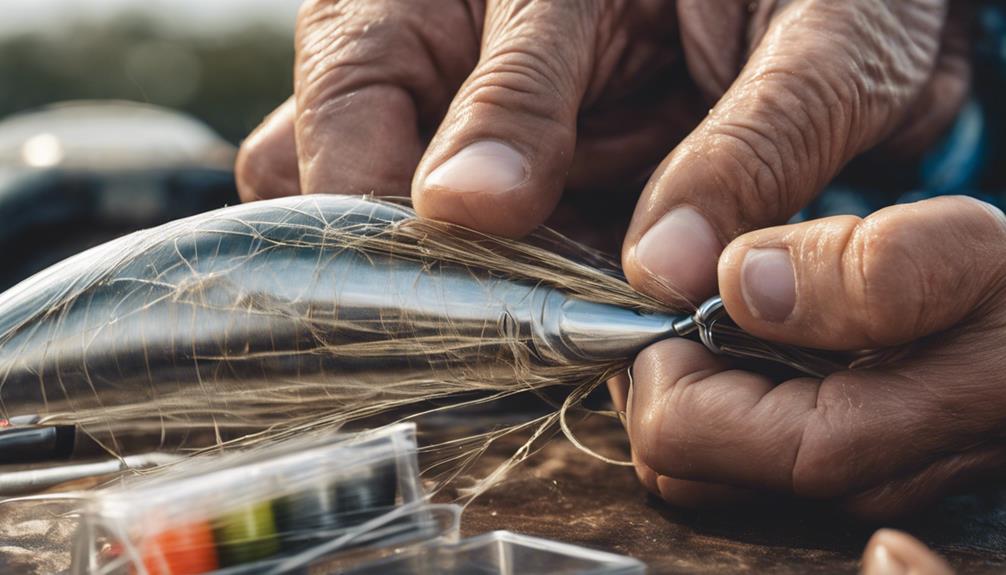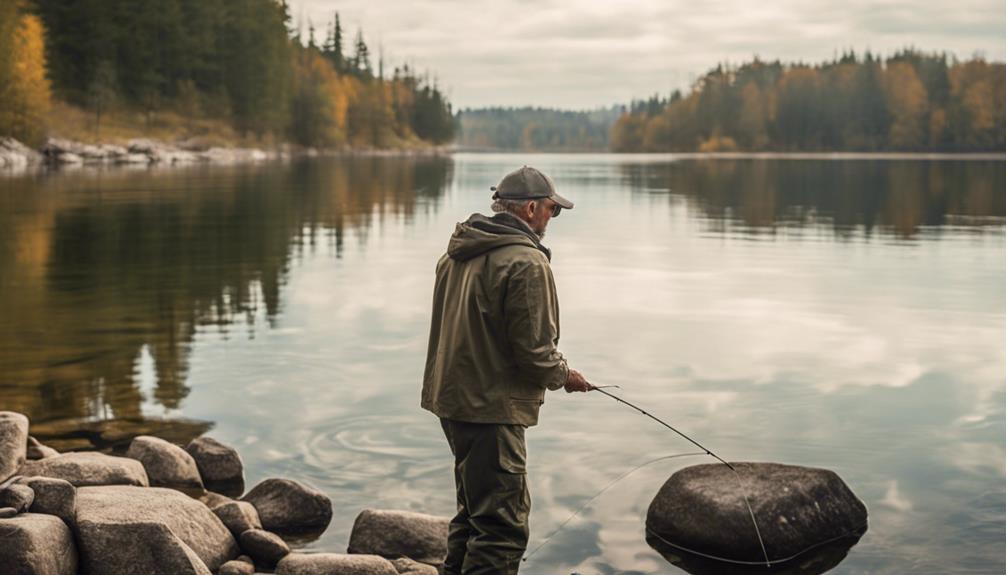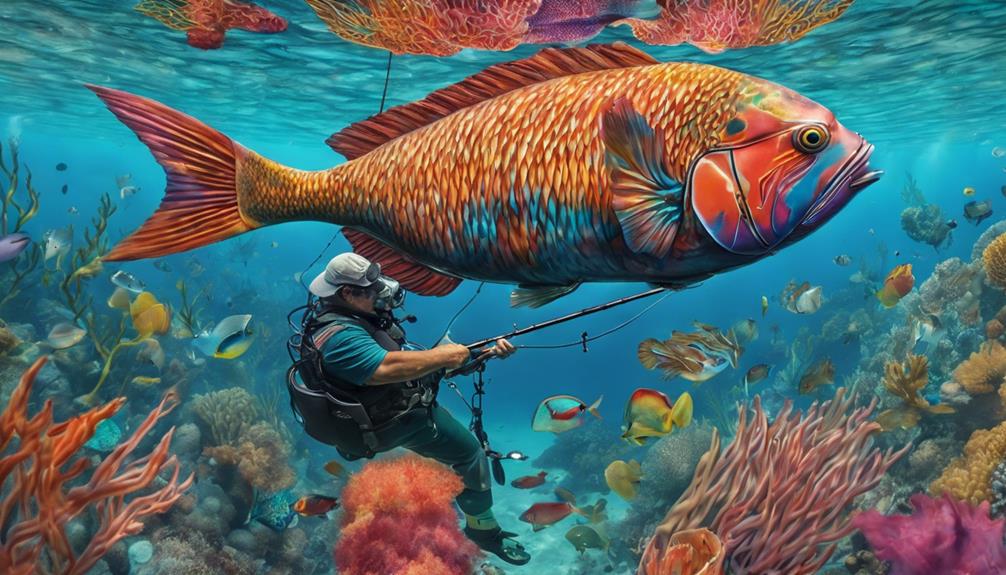Catch the elusive pike with ease using these 14 expert tips.
From mastering the art of lure selection to understanding the intricate behavior of these cunning predators, each tip is a key piece of the puzzle in your quest for pike-specific fishing success.
As you navigate the waters armed with this arsenal of knowledge, you'll soon find yourself reeling in those prized pike like a seasoned angler.
Choosing the Right Rod
Choose a rod that's specifically designed for pike fishing to maximize your chances of success on the water. When selecting a rod for pike fishing, two key factors to consider are rod action and power. Opt for a rod with a fast or extra-fast action to ensure quick hook sets when targeting these aggressive predators. Additionally, choose a rod with heavy power to handle the strength of pike and to effectively control them during the fight.
In terms of rod length, aim for a rod that's around 7 to 8 feet long. This length provides a good balance between casting distance and maneuverability when battling pike. A longer rod allows for longer casts, which can be advantageous when trying to reach distant pike lurking in weed beds or structures.
When it comes to the material of the rod, graphite is a popular choice among pike anglers due to its sensitivity and durability. Graphite rods offer the sensitivity needed to detect subtle strikes from pike, allowing you to react quickly. Moreover, they provide the strength required to handle the powerful runs and sudden movements of these fierce freshwater predators.
Selecting the Ideal Reel
When considering the ideal reel for pike fishing, prioritize durability and smooth drag performance to effectively handle the powerful runs of these aggressive predators. A high-quality reel with a robust construction will withstand the intense fights that pike are known for, ensuring that your gear can handle the stress without failing. Smooth drag performance is crucial when battling pike, as it allows you to adjust the tension quickly during their sudden bursts of energy, helping you maintain control over the fight.
In addition to durability and drag performance, proper reel maintenance is essential for ensuring longevity and optimal performance. Regularly cleaning and lubricating your reel, especially after fishing in saltwater or dirty environments, will help prevent corrosion and keep all components functioning smoothly. It's also important to check for any signs of wear and tear, such as frayed lines or damaged handles, and address them promptly to avoid any issues during your pike fishing adventures.
When it comes to casting techniques, practice accuracy and distance to improve your chances of landing that trophy pike. Work on your casting form to deliver your bait precisely where the pike are lurking, whether it's near structures, drop-offs, or weed beds. Experiment with different casting angles and techniques to find what works best in different fishing situations, allowing you to effectively target these elusive predators.
Picking the Best Line
For optimal pike fishing success, carefully selecting the right line is crucial to handle the strength and aggression of these formidable predators. When choosing the best line for pike fishing, consider the following factors to enhance your chances of landing these powerful fish:
- Line visibility: Pike have keen eyesight and are attracted to movement. Opt for a low-visibility line to prevent spooking wary fish. Fluorocarbon lines are a great choice as they're nearly invisible underwater, increasing your chances of enticing a strike.
- Line strength: Pike are known for their sharp teeth and powerful runs. Select a line with high tensile strength to withstand their aggressive strikes and prevent break-offs. A braided line is a popular option due to its exceptional strength and abrasion resistance.
- Line type: Choose a line type that suits your fishing style. Monofilament lines are more forgiving and have some stretch, which can be beneficial when fighting pike. On the other hand, braided lines offer superior sensitivity, allowing you to detect subtle bites more easily.
- Line diameter: Thicker lines provide more abrasion resistance and strength, making them ideal for targeting large pike in heavy cover. However, thinner lines have less visibility underwater and can cast further, which is advantageous in clear water conditions. Consider the fishing environment and the size of pike you're targeting when selecting the appropriate line diameter.
Optimal Lure Selection
Considering the predatory nature of pike, selecting lures that mimic their natural prey is essential for enticing strikes and maximizing your fishing success. When choosing lures for pike fishing, it's crucial to consider the presentation techniques that will attract these aggressive predators. Opt for large, colorful lures with erratic movements to simulate injured baitfish, which can trigger a pike's predatory instincts. Using lures that resemble the fish commonly found in the pike's habitat, such as perch, walleye, or even ducklings, can significantly increase your chances of a successful catch.
Seasonal lure variations play a significant role in pike fishing success. During the spring and fall when pike are more active, opt for faster-moving lures like spinners, spoons, or jerkbaits. In contrast, in the summer when pike are less active and seek cooler waters, slower presentations with soft plastic lures or live bait may yield better results. Adjusting your lure selection based on the season can make a substantial difference in enticing pike to strike.
Experimenting with different lure sizes, colors, and retrieval speeds, while also considering the water clarity and weather conditions, can help you determine the most effective lure for the day. By mastering lure presentation techniques and understanding seasonal variations, you can enhance your pike fishing skills and increase your chances of a successful outing.
Understanding Pike Behavior
To understand pike behavior effectively, observe their movements in relation to their hunting grounds and feeding patterns. Pike are apex predators, exhibiting specific behaviors based on their prey preferences and seasonal patterns.
Key Insights into Pike Behavior:
- Prey Preferences: Pike are opportunistic feeders, known to consume a variety of prey such as fish, frogs, and even small mammals. Understanding their prey preferences can help you tailor your bait selection to attract pike more effectively. Observing the local ecosystem and the types of prey available in the area can give you valuable insights into what pike might be targeting.
- Seasonal Patterns: Pike behavior can vary significantly depending on the season. During the spring, pike are more active as they recover from the winter months and prepare for spawning. In the summer, they may seek deeper, cooler waters to escape the heat. Understanding these seasonal patterns can help you anticipate where pike are likely to be located at different times of the year.
- Movement and Ambush Tactics: Pike are known for their ambush hunting style. They often lurk in vegetation or near structures, waiting for an opportunity to strike at passing prey. Observing their movements and preferred hiding spots can give you an advantage when targeting pike.
- Territorial Behavior: Pike are territorial fish and tend to establish specific areas as their hunting grounds. By identifying these territories and understanding how pike defend them, you can increase your chances of a successful catch.
Proper Hook and Bait Setup
When selecting your bait and setting up your hook for pike fishing, prioritize using lively and natural-looking lures to entice these predatory fish effectively. Pike are attracted to movement and realistic presentations, so opt for baits that mimic the swimming patterns of their natural prey. To ensure your bait is at the right depth, consider using a combination of floating and sinking lures. Floating lures can be effective for surface fishing, while sinking lures can reach deeper waters where pike often lurk.
In terms of hook setup, make sure your hooks are sharp and in good condition to increase your chances of a successful hookset. When presenting your bait, vary your retrieval speed to create an enticing action that mimics injured prey. This erratic movement can trigger a predatory response from pike, leading to more strikes.
Experiment with different bait presentations to see what works best in the specific fishing conditions you encounter. Sometimes, a slow and steady retrieve is ideal, while other times a fast and jerky motion may be more effective. By adjusting your bait presentation based on the behavior of the pike in that particular area, you can increase your chances of a successful catch. Remember, pike can be picky, so being adaptable and willing to switch up your approach can make a significant difference in your fishing success.
Importance of Leader Material

Using a durable leader material is crucial for pike fishing success, ensuring you can handle the sharp teeth and aggressive behavior of these formidable predators effectively. When choosing the right leader material, consider its benefits, durability, visibility, and strength:
- Benefits: A high-quality leader material offers various benefits such as abrasion resistance, which is essential when dealing with pike's rough jaws and teeth. It also provides better control over the fish during the fight, increasing your chances of successfully landing the catch.
- Durability: Pike have incredibly sharp teeth that can easily cut through inferior leader materials. Opting for a durable leader material ensures it can withstand the pike's teeth, underwater obstacles, and the stress of a vigorous fight without breaking.
- Visibility: Selecting a leader material with high visibility is crucial for pike fishing, especially in murky waters. A visible leader helps you track the movements of the fish and react promptly when they strike, improving your hook-up rate.
- Strength: Pike are powerful predators that put a lot of strain on your gear. A leader material with sufficient strength is vital to handle the sudden bursts of energy and head shakes typical of pike, increasing your chances of landing them successfully.
Essential Accessories for Success
Considering the importance of leader material in pike fishing, equipping yourself with essential accessories can further enhance your chances of success in landing these formidable predators. When it comes to tackle organization and efficient storage on your fishing expeditions, investing in a quality tackle box or bag is crucial. Opt for a sturdy, waterproof option with multiple compartments to keep your lures, hooks, and tools neatly organized and easily accessible. This will save you time on the water and ensure you have everything you need for different fishing techniques.
In terms of fishing technique and bait presentation, having a reliable set of tools can make a significant difference. A good pair of long-nose pliers is essential for safely removing hooks from pike's mouths, especially considering their sharp teeth. Additionally, a strong landing net is vital for smoothly bringing in your catch without risking losing it at the last moment. When it comes to bait presentation, having a selection of wire leaders of different lengths and strengths will allow you to adapt to various fishing conditions and pike behaviors effectively.
Frequently Asked Questions
How Can I Effectively Locate Pike in Different Types of Water Bodies?
To effectively locate pike in different water bodies, pay attention to water temperature and pike behavior.
Understand depth variations and identify ideal structures where pike tend to hide.
Look for areas with cooler water and where pike gather based on the season.
Stay observant and adjust your approach based on the conditions to increase your chances of catching pike successfully.
What Are Some Common Mistakes Beginners Make When Targeting Pike?
When targeting pike, beginners often make common mistakes like using improper equipment and choosing the wrong bait.
To avoid these errors, ensure you have the proper gear, such as strong rods and reliable reels. Additionally, select suitable baits like spoons, spinners, or live bait to entice pike effectively.
How Important Is It to Vary Retrieval Speeds When Using Different Types of Lures for Pike Fishing?
Varying retrieval speeds is crucial for successful pike fishing. The importance of technique shines when using different types of lures. It helps mimic natural prey movements, enticing strikes from these predatory fish.
Proper lure selection combined with skillful retrieval techniques can make a significant difference in your fishing success. Experimenting with speeds can help you figure out what works best for enticing those elusive pike to bite.
Are There Any Specific Weather Conditions That Are Best for Pike Fishing?
When fishing for pike, the best weather conditions include ideal temperatures and the right wind direction. Pike are more active in cooler temperatures, so aim for around 50-65 degrees Fahrenheit.
Wind blowing towards shore can push baitfish closer to the shallows, attracting hungry pike. Keep an eye on the weather forecast and plan your fishing trips accordingly to maximize your chances of success.
What Are Some Key Differences in Technique When Fishing for Pike in Rivers Versus Lakes?
When fishing for pike in rivers versus lakes, you'll need to adjust your techniques.
In rivers, be aware of strong currents that can affect your bait presentation. Your bait selection should match the natural prey in each environment. Practice accurate casting to target specific areas where pike are likely to be lurking.
In lakes, focus on understanding the underwater structure where pike like to hide. Adapt your approach based on the unique conditions of each waterbody.
Conclusion
Now that you have all the expert tips for successful pike-specific fishing, it's time to hit the water and put them into action. Remember to choose the right rod, reel, line, and lure, understand pike behavior, and set up your hooks and bait properly.
Don't forget the importance of leader material and essential accessories for success. With these tips in mind, you'll be well on your way to a productive and enjoyable fishing trip targeting pike.



